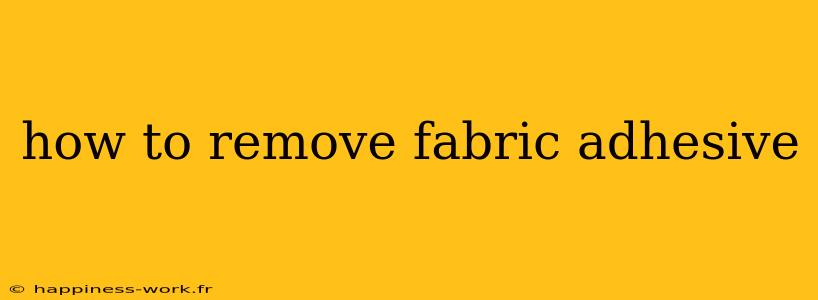How to Remove Fabric Adhesive: A Comprehensive Guide
Fabric adhesive can be a lifesaver for crafting projects, home repairs, and more. But what happens when you need to remove it? Whether you're dealing with a sticky mess from a failed project or simply want to refresh an old item, knowing how to remove fabric adhesive is essential.
This guide will walk you through various methods, drawing on expert advice from WikiHow, the go-to resource for practical life hacks.
Understanding Fabric Adhesives: A Quick Overview
Before diving into removal methods, it's crucial to understand the type of adhesive you're dealing with. Fabric adhesives come in various forms, each with its unique properties and removal challenges:
- Water-based adhesives: These are generally easier to remove, often dissolving with water or gentle cleaning agents.
- Solvent-based adhesives: These are stronger and more durable but require stronger solvents for removal.
- Hot melt adhesives: These are solid at room temperature but melt when heated. They can be tricky to remove, requiring both heat and solvents.
How to Remove Fabric Adhesive: A Step-by-Step Guide
1. Preparation is Key:
- Identify the adhesive type: Determine the adhesive type using the product label or by performing a small test on a hidden area.
- Protect your workspace: Cover your work area with a drop cloth or newspaper to prevent any spills or damage.
- Wear appropriate gear: Wear gloves to protect your hands and a mask to avoid inhaling fumes.
2. Removal Methods:
For Water-Based Adhesives:
- Soapy water: WikiHow recommends using a mild soap solution and a soft cloth or sponge to gently rub the adhesive.
- Warm water: For stubborn residues, try soaking the fabric in warm water for several minutes before scrubbing.
- Dish soap: A small amount of dish soap mixed with warm water can effectively loosen and remove the adhesive.
For Solvent-Based Adhesives:
- Acetone: WikiHow suggests using acetone, a common solvent found in nail polish remover. Apply it to a cotton ball or cloth and gently rub the adhesive area.
- Rubbing alcohol: This readily available solvent can also break down adhesive residue. Apply it to a cotton ball or cloth and rub the affected area.
- WD-40: This multi-purpose product can be effective for loosening stubborn adhesives. Spray a small amount onto the adhesive and let it sit for a few minutes before wiping with a cloth.
For Hot Melt Adhesives:
- Heat and scrape: WikiHow recommends applying heat with a hairdryer or iron to soften the adhesive. Once softened, gently scrape it off with a plastic scraper or putty knife.
- Freezing: Another approach is to freeze the adhesive by placing the item in a freezer bag and leaving it in the freezer for a few hours. The cold temperature makes the adhesive brittle, making it easier to break and remove.
3. Post-Treatment:
- Wash or clean the fabric: Once you've removed the adhesive, wash the fabric as per its care instructions to remove any remaining residue.
- Test for colorfastness: If you're using solvents, it's essential to test them on a hidden area of the fabric first to ensure they don't damage the color or fabric.
Additional Tips from the Experts:
- Don't rush the process: Patience is key when removing fabric adhesive. Work in small sections and allow the solvent to penetrate the adhesive before attempting to remove it.
- Try a combination of methods: If one method doesn't work, try combining it with another. For instance, use heat to soften the adhesive and then apply a solvent to break it down further.
- Be mindful of the fabric: Different fabrics react differently to solvents and heat. Always test any cleaning solution on a hidden area first.
Conclusion:
Removing fabric adhesive can be challenging, but by understanding the type of adhesive and following these expert-backed tips, you can tackle the task successfully. Remember, patience, careful application of the right methods, and a bit of creativity can go a long way in achieving a clean and adhesive-free surface.
